Submitted:
19 September 2023
Posted:
20 September 2023
You are already at the latest version
Abstract
Keywords:
1. Introduction
2. Co-creation methodology
- a rapid scoping review and workshops on key concepts, principles and approaches identified in the science discourse, such as systems thinking and analysis; management change; circular economy principles; regenerative methods; water-energy-food-nexus; polycentric governance; co-creation; shared values; the Three Horizons Framework; scenario planning and policy mapping; Systems Innovation Approach; future visioning, future-scaping, envisioning, transition pathways, adaptive pathways and the ‘What if’ approach; forecasting and backcasting; bioregional planning; landscape frameworks and optioneering; and communication and pedagogy [17,20,23,29,31,36,42,43,44,45,46,47,48,49,50,51,52,53,54,55,56,57,58,59,60,61];
- synthesis of this material into provisional scenarios based on axes of econo-centric to eco-centric and technology for private good to technology for public good.
- co-development of a visualisation ‘architecture’ framework to accommodate visual and narrative description of elaborative content and synthesis;
- co-development of conceptual and technical designs for the illustrations and supporting information;
- co-development of interactive content with links to supporting resources;
- delivery of initial ‘pilot-testing’ to high-level audiences and a formal launch to wider audiences.
- Landscape 1 (L1) - ‘Unsustainable’;
- Landscape 2 (L2) - ‘In Transition’;
- Landscape 3 (L3) - ‘Regenerative Sustainability’;
- Landscape 4 (L4) – Regenerative Utopia/Transformed.
- i.
- Co-defining the system and timescales: sub-systems, capitals, features and actions;
- ii.
- Assessing and visualising system services and nexus outcomes (‘benefits’);
- iii.
- Co-production of illustrations, messages and narrative content.
2.1. Co-defining the system and timescales: sub-systems, capitals, features and actions
- A workshop to brainstorm visualisation of sustainable landscapes – to collate knowledge, references, examples, images, diagrams, ideas and suggestions on perspectives, approaches, frameworks, tools, innovations, features etc to include in the visualisation platform;
- A workshop to undertake scenario and policy mapping – to map out existing policy and suggest potential future policy requirements for three scenarios/horizons/visions along a timeline out to 2050-80 (or ‘open’), covering policy, governance and society and identifying barriers to change at the micro and macro scale;
- A workshop to determine Landscape 1 and 2 feature label allocation, messaging and narrative development tasks – agreeing on label length, content and convention was crucial to ensure consistency in the visualisation platform textual content to enable ease of recognition, association and navigation during the user experience;
- A workshop to explore Landscape 3 features and undertake sharing, monitoring and evaluation planning – to brainstorm ideas for a landscape representing transformation/transition (i.e. including full implementation across the SETS of regenerative, circular, nexus approaches etc).
2.2. Assessing and visualising system services and nexus outcomes (‘benefits’)
2.3. Co-production of illustrations, messages and narrative content
3. User Journey
- As a resource to support fully guided webinar presentations with pre-set narratives or ‘user journeys’ through the use of slide decks.
- As a resource to support a hybrid - part-guided, part self-exploratory - live online session.
- As a resource to support an entirely self-guided session through a user-led journey.
- Landing page – Welcome video, Introduction, User Guide, Landscapes 1-4;
- Landscape 1 – Landscape 1: visualisation of an Unsustainable scenario landscape;
- Landscape 1 – Overall scenario landscape description and scenario wheels;
- Landscape 1 – Zone: Agriculture; Feature: Livestock sheds;
- Landscape 2 - Visualisation and description for Landscape 2: In transition;
- Landscape 2 – Landscape 2: In transition wheels;
- Landscape 2 - Zone: Agriculture; Feature: Livestock sheds;
- Landscape 2 - Zone: Agriculture description, list of Features and wheels;
- Landscape 2 - Zone: Agriculture; Feature: Animal waste digestors description;
- Landscape 2 - Zone: Agriculture; Feature: Animal waste digestors wheels;
- Landscape 3 - Visualisation of Regenerative Sustainability;
- Landscape 3 – Description and wheels.
- (optional step of considering Landscape 4 wireframe)
- A swipe animation from Landscape 1 to Landscape 3;
- A simple animation illustrating the reimagining of wastewater treatment plants as circular ‘bioresource centres’ operating across the nexus;
- Downloadable illustrations, for, for instance, developing bespoke user journeys.
4. Preliminary Evaluation
- co-create an interactive platform through which to explore illustrations and narrative visions of the future underpinned by an extensive evidence synthesis, as well as real-world examples of the ‘art of possible’ and ‘pockets of the future in the present’.
- co-develop illustrations of future regenerative, sustainable, resilient, shared and socially just landscapes to showcase and communicate evidence-based material in relation to sustainability transitions with a focus on water.
- provide accessible, inclusive visualisations and other supporting content to enable stakeholders with highly diverse levels of prior knowledge and technical skills to engage with and co-develop a shared vision for future SETS landscapes.
- provide a robust platform for further information collation, organisation, communication and deliberation.
5. Conclusions
Conclusions:
- The co-creation process outlined provides a useful framework for further visualisatrion, illustration and communication projects;
- Scenarios were an effective way to organize and synthesis scoping review findings into coherent landscape, ‘zone’ and ‘system’ visuals and narratives;
- Scenarios were an effective way to demonstrate transition between unsustainable practices to more sustainable practices;
- Visualisation of evidence was an effective engagement, communication and learning tool for these coherent scenarios for several audiences;
- An interactive Platform supports the linking of real-world examples to the illustrated contents. This is essential to communicate to more operationally-focused decision-makers who need to see examples;
- Not all concepts and principles are easy to visualize or illustrate in the landscapes (e.g. systems, regenerative, circularity and nexus approaches). Therefore, other means are needed such as narrative, animation and links to other resources;
Recommendations:
- When working collaboratively on co-design and co-creation ensure significant time is allocated to workshopping and conceptual elucidation;
- Ensure that interfaces such as the Platform are built using standard software to enable onward collaboration and updating where possible;
- The Platform should be further tested and co-created with a wider set of audiences;
- The Platform Landscapes L1-L3 should be further populated with new findings and examples that are in the Content Organiser but could not be included during the project duration;
- Explanation of concepts and principles could be developed further through narrative, animation and examples;
- The L4 wireframe should be used for (i) developing short-term acceptable / fundable generic or place-based scenario and programme of work using L3 as a ‘pull’; (ii) developing a place-based long-term ambition scenario; (iii) co-developing a more transformational scenario than L3.
Author Contributions
Funding
Data Availability Statement
Acknowledgments
Conflicts of Interest
References
- Secretariat of the Convention on Biological Diversity (2020) Global Biodiversity Outlook 5. Montreal.
- Organisation for Economic Co-operation and Development [OECD] (2015) Governance challenges and suggested tools for the implementation of the water-related Sustainable Development Goals Water and Sustainable Development. From Vision to Action. UN Water Annual International Conference 15-17 Jan. Zaragoza.https://www.un.org/waterforlifedecade/waterandsustainabledevelopment2015/pdf/Governance_OE CD_Tool_paper_final.pdf.
- World Economic Forum (2023) The Global Risks Report 2023 18th Edition INSIGHT REPORT. https://www3.weforum.org/docs/WEF_Global_Risks_Report_2023.pdf.
- Brown, R.R. and Farrelly M.A (2009) Delivering sustainable urban water management: a review of the hurdles we face. Water Science & Technology—WST, 59.5, 2009. [CrossRef]
- Pahl-Wostl (2007) Transitions Towards Adaptive Management of Water Facing Climate and Global Change. Water Resources Management 21(1):49-62. [CrossRef]
- Gleick, P.H. (2018) Transitions to freshwater sustainability. Proceedings of the National Academy of Sciences Sep 2018, 115 (36) 8863-8871; [CrossRef]
- Ma, X. , Xue X., González-Mejía A, Garland J. and Cashdollar J. (2015) Sustainable Water Systems for the City of Tomorrow—A Conceptual Framework. Sustainability 7, 12071-12105; [CrossRef]
- Southern Water (2018) Water Horizons: Southern Water’s Long-Term Asset Management Strategy TA 11.2 Water Horizons: Long Term Asset Management Strategy Technical Annex https://www.southernwater.co.uk/media/1964/ta112-water-horizons-southern-waters-long-term-assetmanagement-stra.pdf.
- Franco-Torres, M. (2021). The path to the new urban water paradigm – From modernity to metamodernism. Water Alternatives 14(3): 820-840.
- Franco-Torres, M. , Rogers B.C. & Harder R. (2020) Articulating the new urban water paradigm, Critical Reviews in Environmental Science and Technology. [CrossRef]
- Bell S (2020) Frameworks for urban water sustainability. WIREs Water, 7 (2), e1411. https://wires.onlinelibrary.wiley.com/doi/10.1002/wat2.1411.
- EEA (2019) Sustainability transitions: policy and practice EEA Report No 09/2019 https://www.eea.europa.eu/publications/sustainability-transitions-policy-and-practice.
- Brown, M. , Haselsteiner, E., Apro, D., Kopeva, D., Luca, E., Pulkkinen, K., Vula Rizvanolli, B., (Eds.), (2018). Sustainability, Restorative to Regenerative. COST Action CA16114 RESTORE, Working Group One Report: Restorative Sustainability. https://www.eurestore.eu/wp-content/uploads/2018/04/SustainabilityRestorative-to-Regenerative.pdf.
- Butler, D., Ward, S. , Sweetapple, C., Astaraie-Imani, M., Diao, K., Farmani, R. and Fu, G. (2016) Reliable, resilient and sustainabl water management: the Safe and SuRe approach. Global Challenges 1 (1). [CrossRef]
- Halbe J, Pahl-Wostl C, Sendzimir J, & Adamowski J (2013). Towards adaptive and integrated management paradigms to meet the challenges of water governance. Water Science & Technology. [CrossRef]
- Warden, J. (2021) What does Regenerative Thinking mean? RSA Journal Issue 4 2021 p27-31.
- International Futures Forum. (2020) Three Horizons Model. https://www.iffpraxis.com/three-horizons (Accessed 11/01/2021). 2021.
- Constanza, R. (2000) Visions of alternative (unpredictable) futures and their use in policy analysis. Conservation Ecology 4(1): 5. [CrossRef]
- Helm, R.v. D (2009) The vision phenomenon: Towards a theoretical underpinning of visions of the future and the process of envisioning Futures 41(2):96-104. [CrossRef]
- Environment Agency (2022) Science and Evidence Synthesis for Water Land Strategy (SES-WLS2100), June 2022. Available on request from authors.
- Raami, A. (2019) Towards Solving the Impossible Problems. Chap 6. In Sustainability, Human Well-Being, and the Future of Education Justin W. Cook Editor. Palgrave Macmillan, Springer Nature Switzerland AG. [CrossRef]
- Yankelovich, D. (1991) Coming to public judgment: making democracy work in a complex world. Syracuse University Press, Syracuse, New York, USA.
- Willow, A. (2022) Visions of transition: centering the future in engaged sustainability research. SN Soc Sci 2, 56. [CrossRef]
- Ward, S. , Paling, N. and Rogers, A. (2022) Mobilising sustainable, water resilient communities: evidence and engagement across scales. Proceedings of the Institution of Civil Engineers - Engineering Sustainability 0 0:0, 1-8 (TBC). [CrossRef]
- Ward, S., Staddon, C., De Vito, L., Zuniga-Teran, A., Gerlak, A. K., Schoeman, Y., Hart, A. and Booth, G. (2019) Embedding social inclusiveness and appropriateness in engineering assessment of green infrastructure to enhance urban resilience. Urban Water Journal, 16 (1), 56-67. [CrossRef]
- McPhearson, T. , Cook, E. M., Berbés-Blázquez, M., Cheng, C., Grimm, N. B., Andersson, E., Barbosa, O., Chandler, D. G., Chang, H., Chester, M. V., Childers, D. L., Elser, S. R., Frantzeskaki, N., Grabowski, Z., Groffman, P., Hale, R. L., Iwaniec, D. M., Kabisch, N., Kennedy, C., Markolf, S. A., Matsler, A. M., McPhillips, L. E., Miller, T. R., Muñoz-Erickson, T. A., Rosi, M. and Troxler, T. G. (2022) A social-ecological-technological systems framework for urban ecosystem services. One Earth, 5 (5), 505-518. [CrossRef]
- Linton, J. and Krueger T. (2020) The ontological fallacy of the Water Framework Directive: Implications and alternatives. Water Alternatives 13(3): 513-533.
- 28. Vining, Joanne, et al. “The Distinction between Humans and Nature: Human Perceptions of Connectedness to Nature and Elements of the Natural and Unnatural.” Human Ecology Review, vol. 15, no. 1, 2008, pp. 1–11. JSTOR. https://www.jstor.org/stable/24707479. Accessed 24 May 2023. 24 May.
- Bibri, S.E. (2018) Backcasting in futures studies: a synthesized scholarly and planning approach to strategic smart sustainable city development. Eur J Futures Res 6, 13 (2018). [CrossRef]
- Quist, J and Vergragt, P. (2006) Past and future of backcasting: The shift to stakeholder participation and a proposal for a methodological framework. Futures,38 (9). [CrossRef]
- Reinsborough, M. (2017). Science fiction and science futures: considering the role of fictions in public engagement and science communication work JCOM 16(04), C07. [CrossRef]
- Government Office for Science (2017) Futures Toolkit Tools for Futures Thinking and Foresight Across UK Government https://assets.publishing.service.gov.uk/government/uploads/system/uploads/attachment_data/file/674209/futures-toolkit-edition-1.pdf.
- Priest, S. H. (2009). Curiouser and curiouser. Science Communication, 31(1), Sage. [CrossRef]
- Corner, A. , Shaw, C. and Clarke, J. (2018). Principles for effective communication and public engagement on climate change: A Handbook for IPCC authors. Oxford: Climate Outreach.
- Corner, A. , Shaw, C., Clarke, J. and Wang, S. (2018). Communicating Environmental and Sustainability Science - Challenges, opportunities, and the changing political context. Oxford: Climate Outreach.
- Hopkins, R. (2019) From What Is to What If: unleashing the power of imagination to create the future we want. Chelsea Green Publishing, UK. ISBN-101645020290, ISBN-13-978-1645020295. https://www.robhopkins.net/the-book/.
- Kelesidou, F. and Chabrol, E. (2021) A comprehensive guide to Science Communication. RRI Tools. https://rri-tools.eu/-/a-comprehensive-guide-to-science-communication.
- Government Office for Science (2021) A brief guide to futures thinking and foresight https://assets.publishing.service.gov.uk/government/uploads/system/uploads/attachment_data/file/1113574/A_Brief_Guide_to_Futures_Thinking_and_Foresight_-_2022.pdf.
- Government Office for Science (2022) Futures, Foresight and Horizon Scanning: tips on developing a collective futures vision with the public. https://foresightprojects.blog.gov.uk/2022/05/18/tips-on-developing-a-collective-futures-vision-with-the-public/.
- Government Office for Science (2022) Futures, Foresight and Horizon Scanning: effectively creating and communicating futures outputs. https://foresightprojects.blog.gov.uk/2022/03/10/effectively-creating-and-communicating-futures-outputs/.
- Hofvenschioeld, E. and Khodadadi, M. (2020) Communication in futures studies: a discursive analysis of the literature. Futures, 115, 102492. [CrossRef]
- Sharpe, B., A. Hodgson, G. Leicester, A. Lyon, and I. Fazey. 2016. Three horizons: a pathways practice for transformation. Ecology and Society 21(2):47. [CrossRef]
- Dockerty, T. , Lovett, A., Appleton, K., Bone, A. and Sünnenberg, G. (2006) Developing scenarios and visualisations to illustrate potential policy and climatic influences on future agricultural landscapes. Agriculture, Ecosystems & Environment, 114 (1), 103-120, ISSN 0167-8809. [CrossRef]
- Schmitt Olabisi, L.K.; Kapuscinski, A.R.; Johnson, K.A.; Reich, P.B.; Stenquist, B.; Draeger, K.J. (2010) Using Scenario Visioning and Participatory System Dynamics Modeling to Investigate the Future: Lessons from Minnesota 2050. Sustainability, 2, 2686-2706. [CrossRef]
- Edquist, C. and Hommen, L. (1999) Systems of innovation: theory and policy for the demand side. Technology in Society, 21 (1), 63-79, ISSN 0160-791X. [CrossRef]
- De Vicente Lopez, J. and Matti, C. (2016) Visual toolbox for system innovation. A resource book for practitioners to map, analyse and facilitate sustainability transitions. Transitions Hub Series. Climate-KIC, Brussels 2016. ISBN 978-2-9601874-0-3.
- ARSINOE (2022) The Project: ARSINOE at a glance. https://arsinoe-project.eu/the-project/ (Accessed 09-08-2022).
- Sheppard, S. R. J. (2006) Bridging the sustainability gap with landscape visualisations in community visioning hubs. The Integrated Assessment Journal Bridging Sciences and Policy, 6 (4), 79-108.
- Wiek, A. , Iwaniec, D. Quality criteria for visions and visioning in sustainability science. Sustain Sci 9, 497–512 (2014). [CrossRef]
- Gaziulusoy, A. I. and Ryan, C. (2017) Roles of design in sustainability transitions projects: A case study of Visions and Pathways 2040 project from Australia. Journal of Cleaner Production, 162, 1297-1307. ISSN 0959-6526. [CrossRef]
- Angheloiu, C. , Chaudhuri, G. and Sheldrick, L. (2017) Future Tense: Alternative Futures as a Design Method for Sustainability Transitions. The Design Journal, 20 (1), S3213-S3225. [CrossRef]
- Sadr, S. M. K., Casal-Campos, A., Fu, G., Farmani, R., Ward, S. and Butler, D. (2020) Strategic planning of the integrated urban wastewater system using adaptation pathways. Water Research, 182. [CrossRef]
- Werners, S. E. , Wise, R. M., Butler, J. R. A., Totin, E. and Vincent, K. (2021) Adaptation pathways: A review of approaches and a learning framework. Environmental Science & Policy, 116, 266-275, ISSN 1462-9011. [CrossRef]
- Bengston, D. N. , Westphal, L. M., & Dockry, M. J. (2020). Back from the Future: The Backcasting Wheel for Mapping a Pathway to a Preferred Future. World Futures Review, 12(3), 270–278. [CrossRef]
- Fanfani, D. and Mataran Ruiz, A. (Eds) (2020) Bioregional Planning and Design: Volume I. Perspectives on a Transitional Century. Springer Cham, Switzerland. [CrossRef]
- Taylor Lovell, S. and Johnston, D. M. (2008) Creating multifunctional landscapes: how can the field of ecology inform the design of the landscape? Frontiers in Ecology and the Environment, 7 (4), 212-220. [CrossRef]
- Bohnet, I.C. , Roebeling, P.C., Williams, K.J. et al. (2011) Landscapes Toolkit: an integrated modelling framework to assist stakeholders in exploring options for sustainable landscape development. Landscape Ecology, 26, 1179. [CrossRef]
- Bryan, B. A. , Crossman, N. D., King, D. and Meyer, W. S. (2011) Landscape futures analysis: Assessing the impacts of environmental targets under alternative spatial policy options and future scenarios. Environmental Modelling & Software, 26 (1), 83-91, ISSN 1364-8152. [CrossRef]
- Kearney, M. , Schuck, S., Burden, K., & Aubusson, P. (2012). Viewing mobile learning from a pedagogical perspective. Research in Learning Technology, 20(1). [CrossRef]
- Bjorke, S. A. (2014) Education for Sustainable Development: Pedagogical approaches in online education. https://ufbutv.com/2014/02/26/pedagogical-approaches-in-online-education/ (Accessed 07-11-2022).
- Salmon, G. (2022) The 5 Stage Model for 2022 and Beyond. https://www.gillysalmon.com/five-stage-model.html (Accessed 10-11-2022).
- Bours, D. , McGinn, C. and Pringle, P. (2014) Guidance note 3: Theory of Change approach to climate change adaptation programming. https://www.ukcip.org.uk/wp-content/PDFs/MandE-Guidance-Note3.pdf (Accessed 10-08-2022).
- UNEP (2022) Theory of Change. https://www.unep.org/evaluation-office/our-evaluation-approach/theory-change#:~:text=The%20Theory%20of%20Change%20of,can%20lead%20to%20the%20next. (Accessed 10-08-2022).
- Thomsen, D. C. (2015) Seeing is questioning: prompting sustainability discourses through an evocative visual agenda. Ecology and Society, 20(4). http://www.jstor.org/stable/26270309.
- Peterson St-Laurent, G. , Hoberg, G., Sheppard, S. R. J. and Hagerman, S. M. (2020) Designing and evaluating analytic-deliberative engagement processes for natural resources management. Elem Sci Anth, 8: 8. [CrossRef]
- Defra (Department for Environment, Food and Rural Affairs) (2017) Local Action Plan: Final Report WT1580 Defra London, UK. http://randd.defra.gov.uk/Document.aspx?Document=13980_WT1580_LocalActionProject_Finalreport.pdf (accessed 16/07/2022) Google Scholar.
- Defra (2019) Local Action Project 3: Working with Local Communities to Enhance the Value of Natural Capital in Local Landscapes to Improve People’s Lives, the Environment and Economic Prosperity Defra London UKWT1595. http://sciencesearch.defra.gov.uk/Document.aspx?Document=14617_WT1595_Local_Action_Project_3_FINAL.pdf (accessed 16/07/2022) Google Scholar.
- Pettit, C.J. Raymond, C. M., Bryan, B. A., and Lewis, H. Identifying strengths and weaknesses of landscape visualisation for effective communication of future alternatives. Landscape and Urban Planning. (2011). [CrossRef]
- Glaas, E. , Ballantyne A. G., Neset T-S., and Linnér B-O. (2017). Visualization for supporting individual climate change adaptation planning: assessment of a web-based tool. Landscape and Urban Planning, 158, 1-11. [CrossRef]
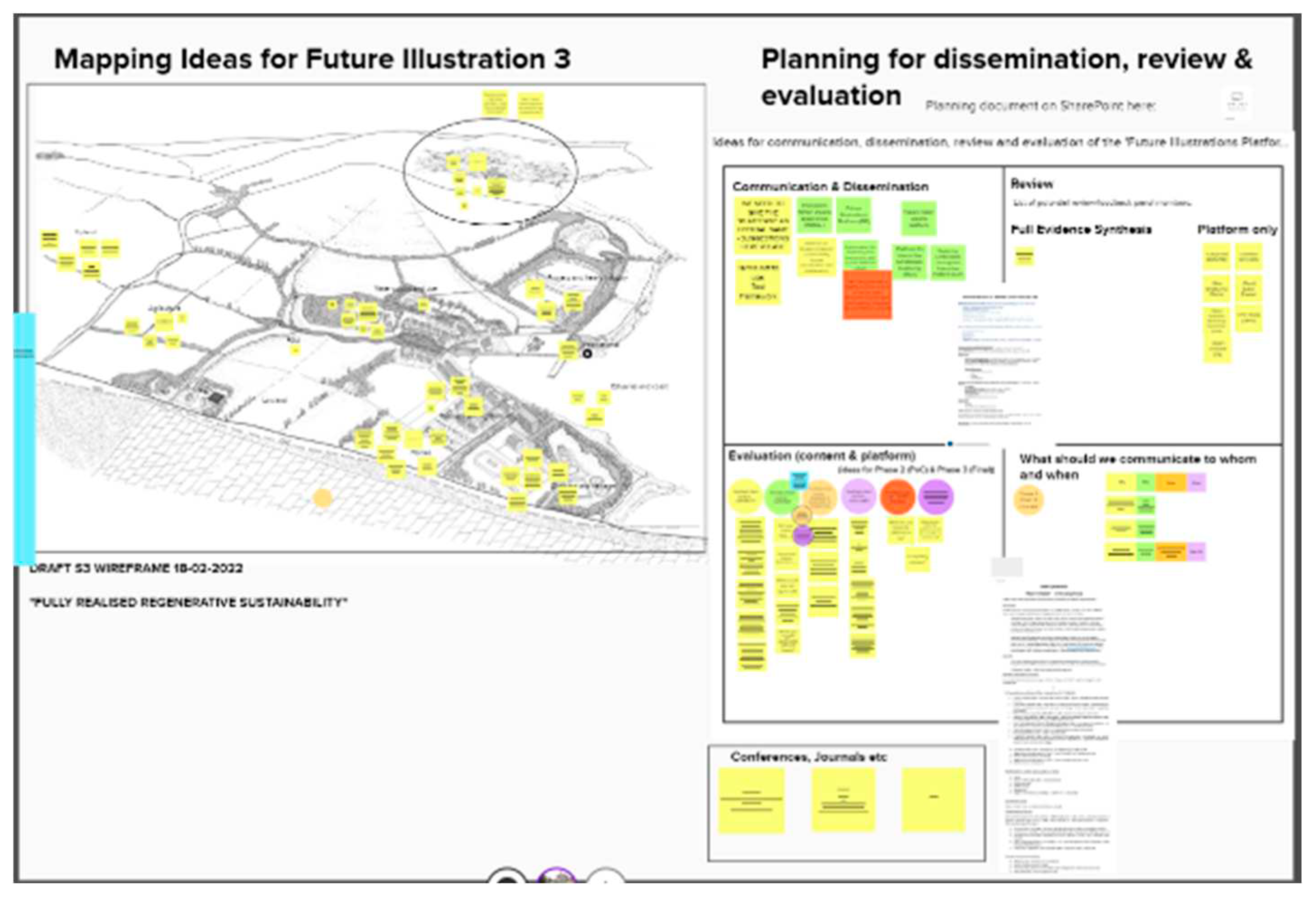
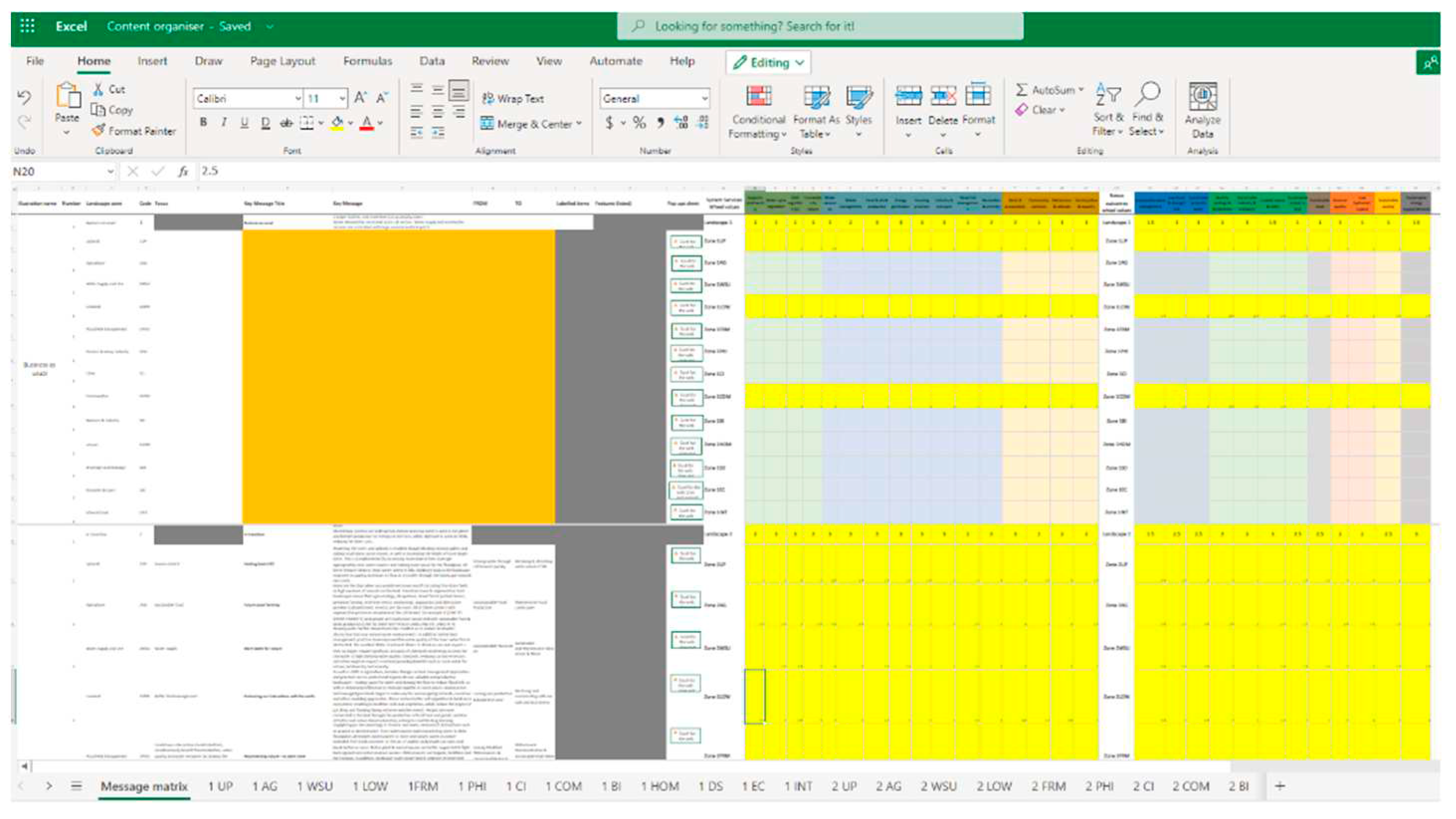
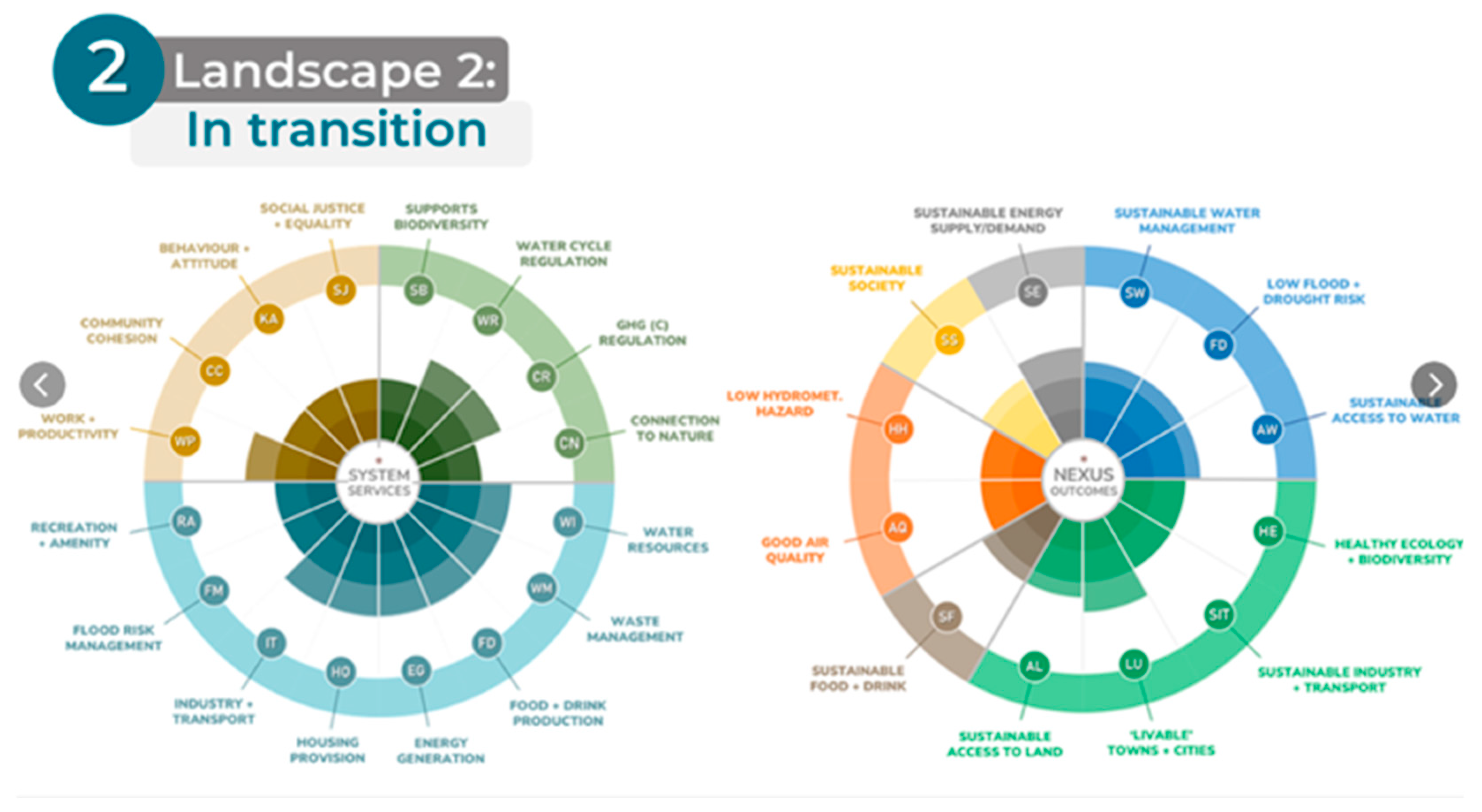
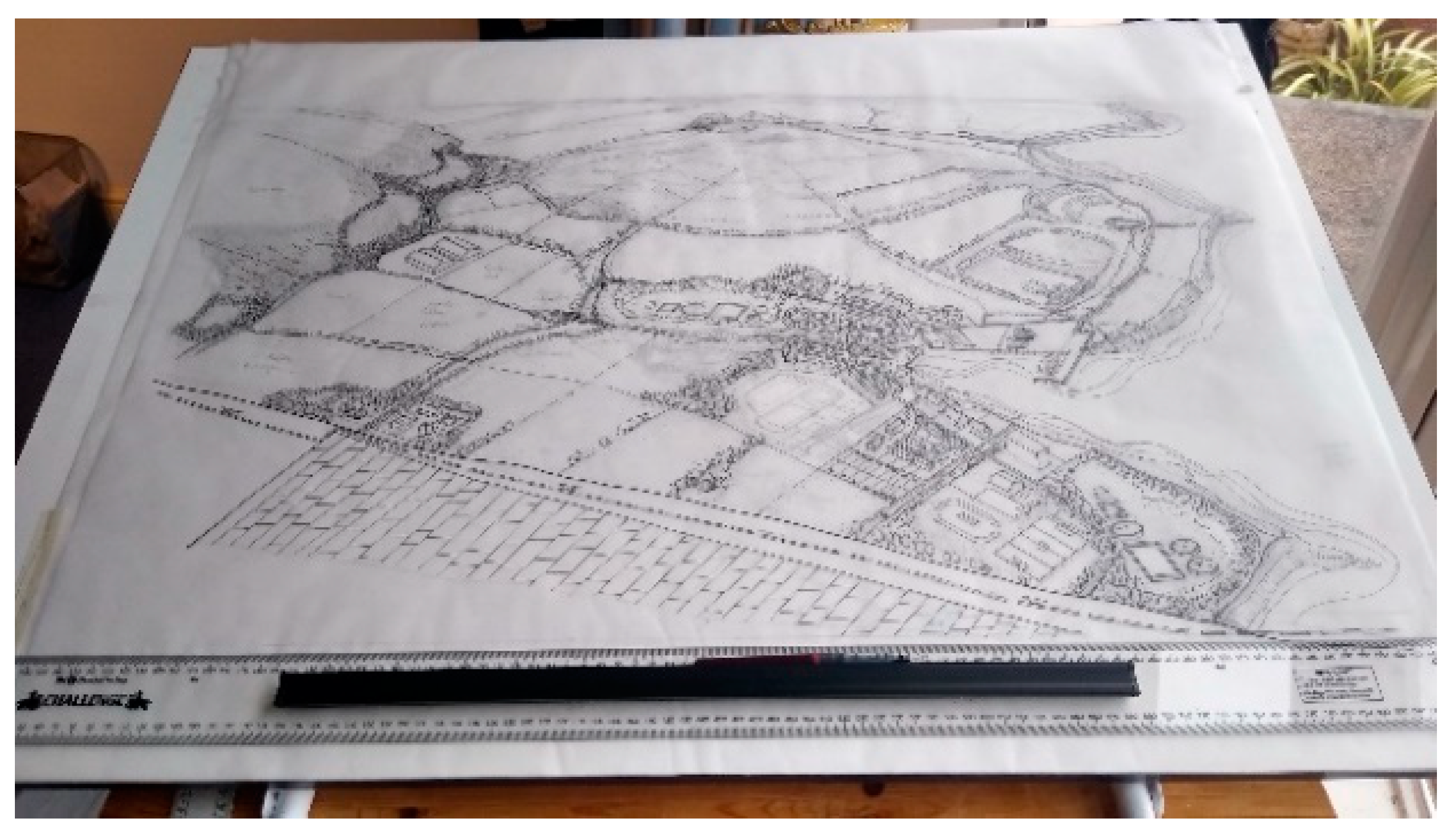
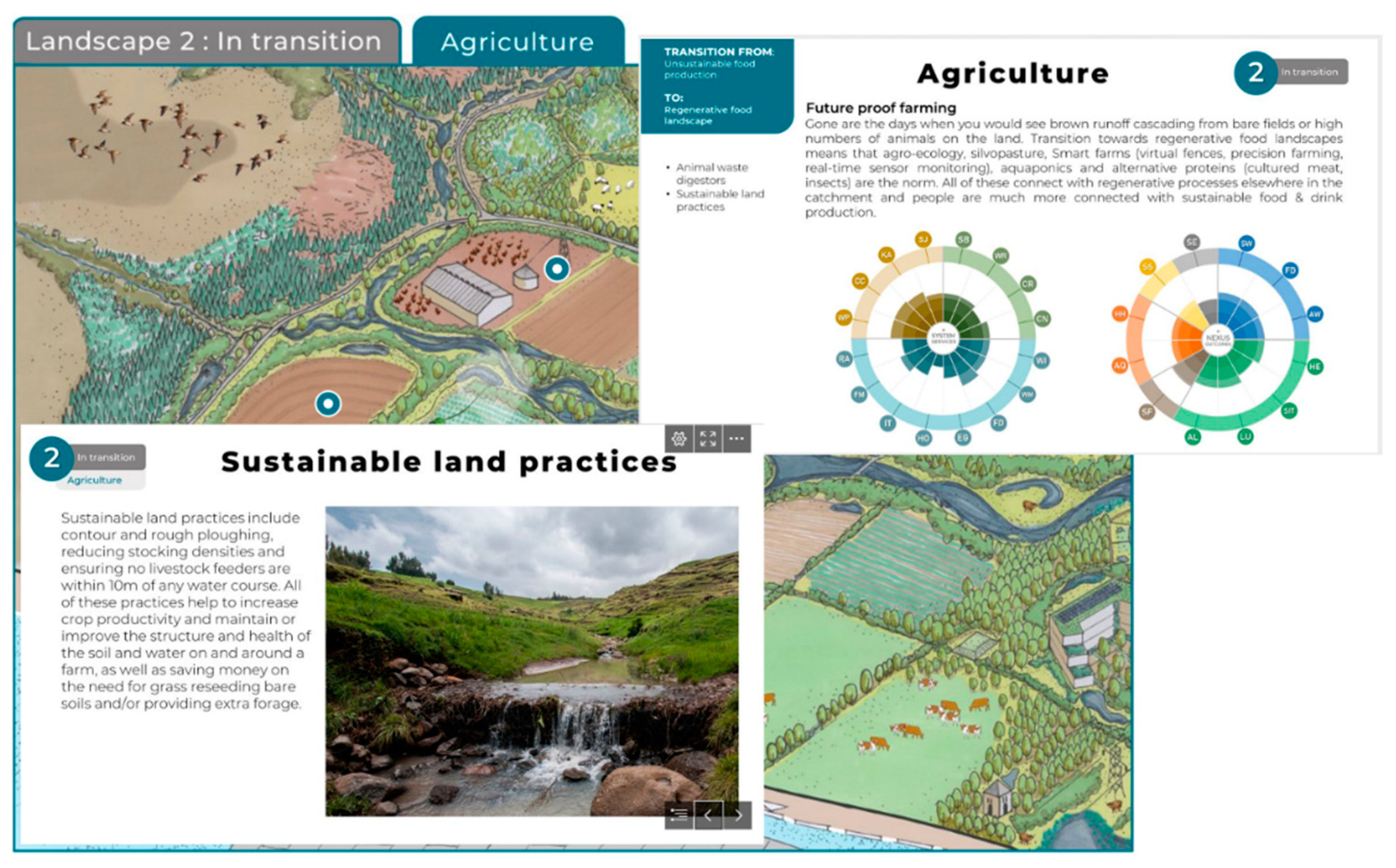
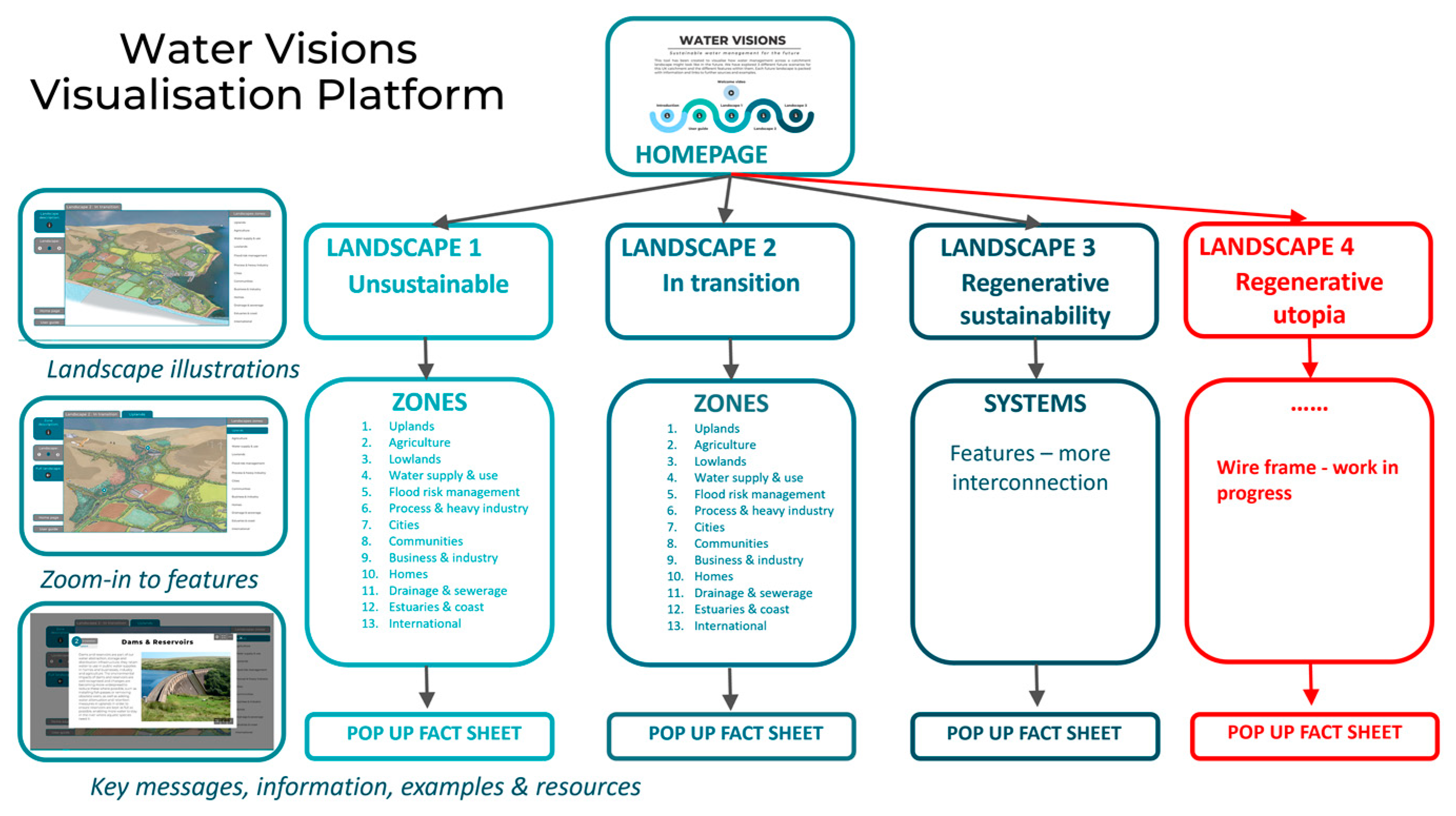
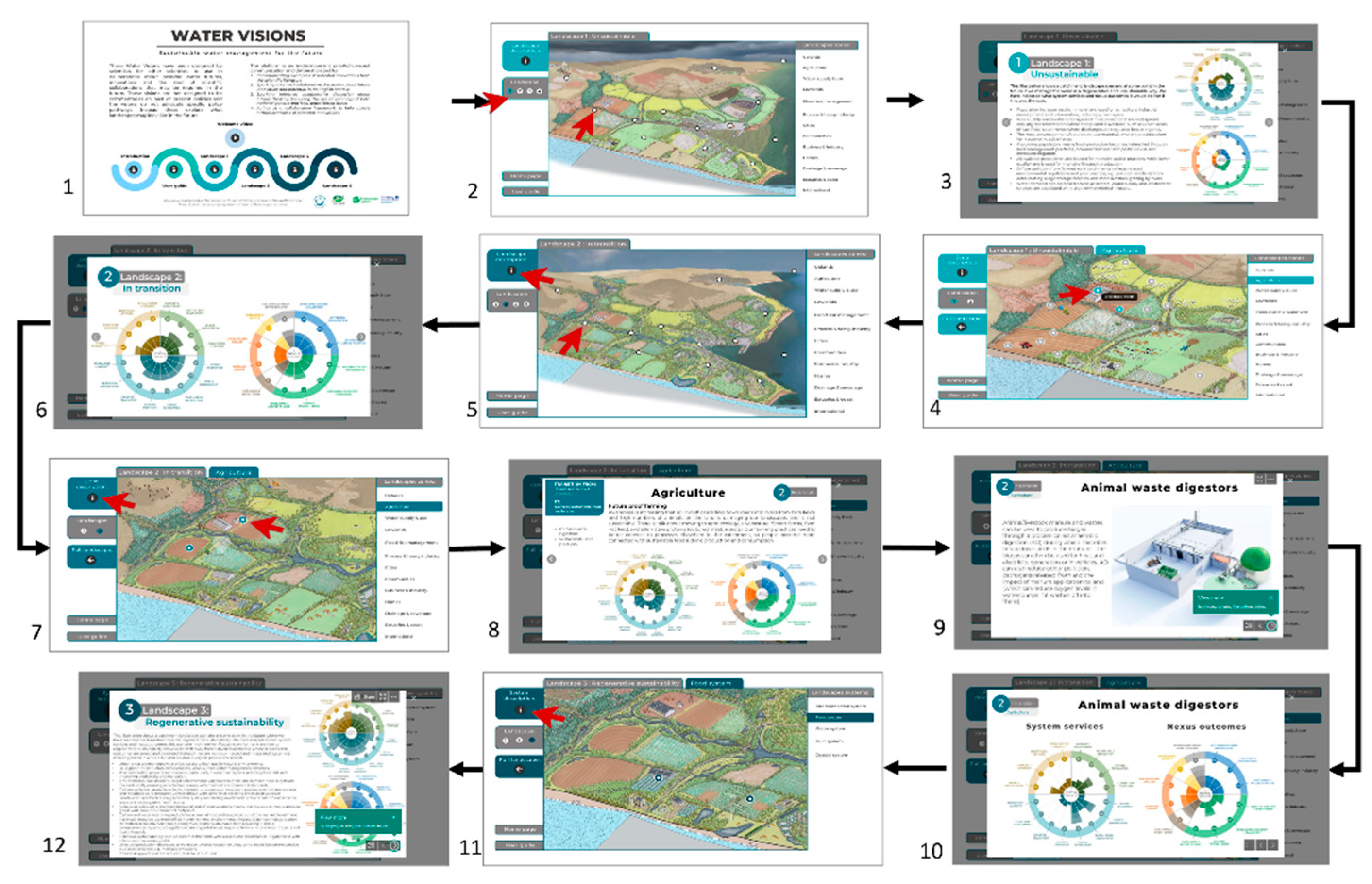
| Framing for Compliance (Unsustainable); H1; L1 | Framing for regenerative sustainability and resilience (futures); L2 and L3 | Actions/Potential for influence (for existing decision makers) | Real world example/s | Representation in Visualisation Platform |
|---|---|---|---|---|
| Addresses symptoms and ecological (and some e.g. health) consequences | Addresses systemic causes | Co-develop more ‘upstream’ regenerative & sustainable win-win systems -focused interventions (ideally at source), including design and retrofit, generating zero-pollution/environmental & social harm (aka net zero carbon) | 3 capitals/systems approach – natural systems, infrastructure systems (natural & built), social systems (social & cultural). | Landscape features map onto these systems & demonstrate their interdependencies |
| Non-regenerative (i.e. degenerative), non-resilient, biophysical water-only system with incompletely implemented linear & siloed working & governance and competing incentives focused on mitigation, restoration & inflexible, ‘one approach fits all’ permanence | Regenerative, resilient nexus-focused Socio-ecological-technological system based (SETS) with fully implemented circular & systemic working and polycentric systemic governance incentivised for sustainability focused on reuseability, adaptation & flexible, ‘fit for use’ impermanence |
|
|
|
| Neo-liberal (private good, profit driven), technocratic & opaque with limited understanding of negative unintended consequences. Clearly unfair /unjust and consequently leading to unhappiness and poor health and wellbeing. Unhealthy food and urban systems. | Social (public good, shared value driven), democratic & transparent with understanding of risk & trade-off management. Driven to be fair/just leading to happiness and improved health and wellbeing. Healthy food and urban systems. |
|
|
|
| Non-evaluative & nonadaptive, lags behind current thinking & science | Evaluative & adaptive, keeps up with & drives current thinking & science (innovation) |
|
|
|
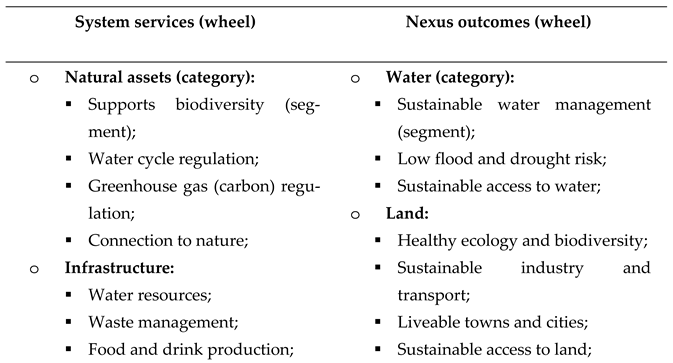
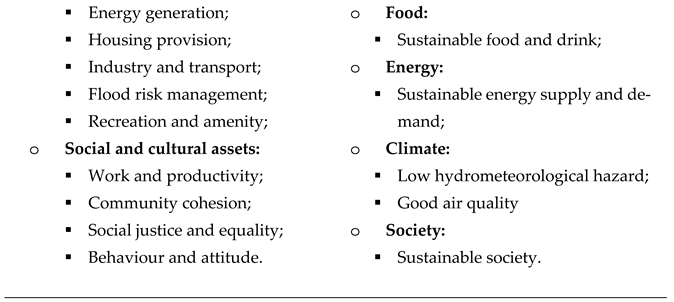
| # | Criteria | Achieved? | How? |
|---|---|---|---|
| 1 | Promotes understanding of futures thinking as being imperfect and exploratory | Yes | Introductory, disclaimer and item description texts cover this in their narratives |
| 2 | Explores a particular question | Yes | The question/aim is provided in the Introduction/Welcome |
| 3 | Grounds thinking in data and trends whilst recognising creative thinking and distinguishing between objective facts and imaginative visions | Yes | Evidence-based [19], which underpins narratives with imaginative illustrations to support creative thinking |
| 4 | Uses ‘What? So what? Now what?’ questions to explore impacts and include next steps, time-frames, impact severity and interconnections | Yes | Benefits wheels provide the ‘so what’, potential impacts and interconnectivity, guiding next steps and time-frames for consideration |
| 5 | Uses narratives and storytelling for visualisation | Yes | Illustrated landscapes, zones, systems and features are accompanied by a textual narrative, which weaves a wider story |
| 6 | Asks the audience how they want to be communicated with. The language, content and format(s) should be audience specific and understood from the outset | Yes | Methodology includes co-creation to embed these aspects |
| 7 | Recognises uncertainty and tipping points | Yes | Narratives are framed using uncertainty and multiple illustrations indicate there is no set future |
| 8 | Clearly defined purpose, aim, objectives | Yes | The question/aim is provided in the Introduction/Welcome |
| 9 | Strategic and evidence-based, with links to the evidence embedded to provide accuracy and legitimacy | Yes | Evidence-based [19], with links to the evidence embedded in the clickable pop-ups (journal papers, reports, websites, videos, animations, images, podcasts) |
| 10 | Current and future scenarios, as well as a variety of scenarios | Yes | L1 – current, L2 & L3 – futures, L4 – co-creatable wireframe |
| 11 | Accessibility/easily accessible, including software used | Yes | Heavily Microsoft Office-biased, as this tends to be industry standard in the country of origin (UK) but could be substituted with other preferred software |
| 12 | Includes a User guide | Yes | User guide provided on website and landing page of Platform |
| 13 | Zoom-in ability (similar to ‘virtual globe’) | Yes | Illustrations decrease in scale to facilitate zooming |
| 14 | Interactive view and explore function | Yes | Clickable pop-ups and navigation icons provide interaction and explore functions |
| 15 | Easily navigable | Yes | Navigation is via click and go, which is familiar to most audiences |
| 16 | Easy to interpret/understand | Yes | Format follows standard protocols, content is designed to avoid cognitive overload (short text boxes etc) |
| 17 | Clear visuals (e.g. text/pixel size), assumptions, limitations and methods | Yes | Appropriate font sizes and image resolution |
| 18 | Includes spatial and policy aspects | Yes | Spatial element provided through use of landscapes, zones and systems; policy elements contained within narratives |
| 19 | Media in a variety of formats to engage users | Yes | Links out to journal papers, reports, websites, videos, animations, images, podcasts and others |
| 20 | Cost/benefit/trade-off/performance information | Yes | Benefits wheels and narrative elements in pop-ups |
| 21 | Supports stakeholder engagement | Yes | Co-created amongst stakeholders and can be used as a stakeholder engagement tool |
| 22 | Facilitates reflection | Yes | Supports ‘what if’ thinking, which is inherently reflexive |
| 23 | Enables co-development/co-creation | Yes | Co-created amongst stakeholders, L4 specifically included for co-creation/workshopping and Platform can be further co-developed as is fully reconfigurable |
| 24 | Supports learning (including social learning) | Yes | Enables users to acquire and apply new knowledge; can bring together multiple users to share and learn together |
| 25 | Supports online/workshop collaboration | Yes | Parallel exploration possible and L4 specifically included for co-creation/workshopping |
| 26 | Empowers decision making at a range of levels | Yes | Enables users to compare and consider a range of interventions and actions |
| 27 | Opportunity for face to face support (e.g. through knowledge brokers) | Yes | Authors can provide support or train others to provide support |
| 28 | Is useful and satisfies users’ needs | Yes | Indicated through co-creation process and user feedback |
| 29 | Climate change is framed as a phenomenon personally relevant to the target audience | Yes | Yes, includes individual-scale interventions and actions |
| 30 | Communication on risks and impacts resonates with local practices, values, concerns and previous experiences | Yes | Narratives are grounded in the local (though currently context-specific to UK) |
| 31 | Communication provides opportunities to explore impacts by oneself | Yes | Self-guided user journey option |
| 32 | Information is transparent: uncertainties are made understandable and are visualized to appear credible | Yes | All narratives, wheels and pop-ups are framed in this way |
| 33 | Information is not over-simplified | Yes | Narratives and media are clear and use explicit rather than simple language with definitions provided where needed and in a glossary and List of Features to support |
| 34 | Not only fearful messages are spread | Yes | Message framings and narratives are realistic but optimistic and hopeful |
| 35 | Information relates to established implementation barriers | Yes | Evidence-based barriers are framed appropriately |
| 36 | Communication presents clear options and lists of alternative adaptation measures to choose from | Yes | Clickable item menus and List of Features clearly convey options |
| 37 | Communication on actions is tailored to the needs and objectives of the target audience and relates to everyday concerns | Yes | Everyday concerns are articulated through Features that work less well (L1) and work better (L2, L3) at different scales for a range of audiences |
| 38 | Adaptation options are visualised | Yes | Illustrations, imagery and multi media |
| 39 | It is clear how individual adaptative responses can make a difference | Yes | Through benefits wheels and narratives |
| 40 | Communication enhances engagement and discussion among users | Yes | User feedback indicates the Platform is being used to communicate future water vision interventions and action within and amongst different groups |
| Theme | Comment |
|---|---|
| General | Thanks everyone - great and interesting presentation |
| Thanks so much for sharing - great work | |
| Excellent...thanks | |
| Thanks, food for thought, hope we can use it in our work | |
| Thanks all. love this work | |
| Great presentation, many thanks | |
| Thank you- really amazing - great to see this emergingThis is all amazing thank you so much for presentation and tour, really fascinating work. | |
| Navigation | I found that where I was to go next not always clear, but that just maybe me! |
| Visuals/Platform | Excellent graphics, really strong navigation and great overall look and feel |
| Platform looks very good | |
| Illustrations are really clear and comprehensive and underpinning text and sources are helpful; could be enhanced through additional features such as short videos/sound files; vignettes from different 'personas', etc | |
| Illustrations were good and clear and easy to navigate between landscapes etc. Although urban areas were included overall the landscape did look quite rural although that may be representative of actual real-life proportions? There were areas that looked liked towns, but nothing that looked like a city. | |
| How do the landscapes take into account the additional pressures/risks that climate change will place on them? | |
| Which organisation created the platform? E.g. the drawings and assembling the interactive elements? | |
| Noticing that the illustrations are prepared by a Landscape Architect, and encapsulate thinking and skills of that profession. Can the creative and artistic skills used here be acknowledged and promoted? | |
| Futures | Interesting alternative futures - EEA have different imaginaries to 2050 that are more generic Imagining sustainable futures for Europe — European Environment Agency (europa.eu) |
| The realistic descriptions of BAU are welcome | |
| Surely there is a plausible scenario that is worse than BAU - why isnt it included | |
| Why 2100? is this too far in the future? will people be able to engage effectively with this timescale? can there be some interim timescale? | |
| Thank you for presenting a really positive view of our future, it certainly feels like it has achieved what is intended and gives hope. A pressure that is quite significant on the emphasis on community involvement is time availability and often this links to employment - forgive me if I missed it but is employment/how we work factored in to the model? | |
| Approach is dominated by eco-technical scenario that may not be successful and sufficient – sorry | |
| Video/animation/sound | In the video for 'Circularity of bioresource centre' I thought it was completely silent until the sound of the toilet flushing, which then meant I was unsure if there should have been any other sounds throughout the video so turned volume up in case I was missing anything, to just have one sound seems a bit strange. The last slide in that video could do with staying up a bit longer to give people time to have a proper read of the points. |
| Wheels | I was unsure in the scoring system of the nexus wheels if 1 or 5 was good/bad, it would maybe be useful to say this in the user guide in the relevant section. |
| Hi...great work....be interested to know if the scales on the wheels are qualitative or quantitative. Thanks | |
| Technical information | How are land utilisation change and functional vegetation types on these lands considered here at hydrological basin level from the perspective of soil composition and porosity change, hydraulic conductivity etc. at say, A and B horizons to understand 1) temporal and quantitative variation of run-off discharged into rivers, and 2) pollution load and carrying capacity of increased run-offs where this is observed? NB: these observations relate also to aquifer recharge time and future water quality. Apologies for the long question 😊Thank you. |
| Livestock sheds could/should include issues around air quality re ammonia emissiosn | |
| What about non-coastal sewerage discharges? Is there a scenario for that? | |
| I may have missed it but was there anything on changes to transportation, goods and people? | |
| I think I know what green and blue skills are, but what are grey/black - assume it is not concreting and tarmacing! | |
| Is there a vision that these features might be presented as Expected and investment opportunities suggested with planning status etc | |
| Audience/users | To what extent was the platform co-created with users to ensure it meets their needs? |
| Are you planning to track how the tool is used and its impacts? | |
| Do you have a feel for who would be the principle user group? I can see a scenario where it is of more use for policy makers in its depiction of a standardised catchment but in practice it will be accessed and used more by those looking to make local environmental improvements. Does the tool have a mechanism to explore the information tailored to groupings of catchment type? | |
| I can see this being a really useful engagement tool but as currently populated is not so relevant to a developing world context (my interest). However the approach and framework could be used to produce such a version | |
| Learning | It's a great platform and is quite fun to use with all the different landscapes and buttons. I will probably spend longer another time having a proper look around the platform and linking through to some of the articles etc. You could spend a lot of time on it which would be really worthwhile for learning. |
| The complex interplay of each individual issue and how they can impact upon the whole. | |
| Importance of taking a forward-looking systems and Nexus approach; seeking systemic transformation and building underpinning competencies and capabilities to achieve sustainable futures | |
| Glitching | I just had a couple of issues. One was that I couldn't open the user guide in the sidebar of the landscape section, I had to go back to the homepage and then into the user guide (I wanted to do this to double check if the nexus wheel 1-5 scoring system said which was good or bad). The second was I had a box pop up with an error randomly, then when I came out of the landscape and back into it it did work the second time, but this could put people off from persevering with the platform. |
Disclaimer/Publisher’s Note: The statements, opinions and data contained in all publications are solely those of the individual author(s) and contributor(s) and not of MDPI and/or the editor(s). MDPI and/or the editor(s) disclaim responsibility for any injury to people or property resulting from any ideas, methods, instructions or products referred to in the content. |
© 2023 by the authors. Licensee MDPI, Basel, Switzerland. This article is an open access article distributed under the terms and conditions of the Creative Commons Attribution (CC BY) license (https://creativecommons.org/licenses/by/4.0/).





